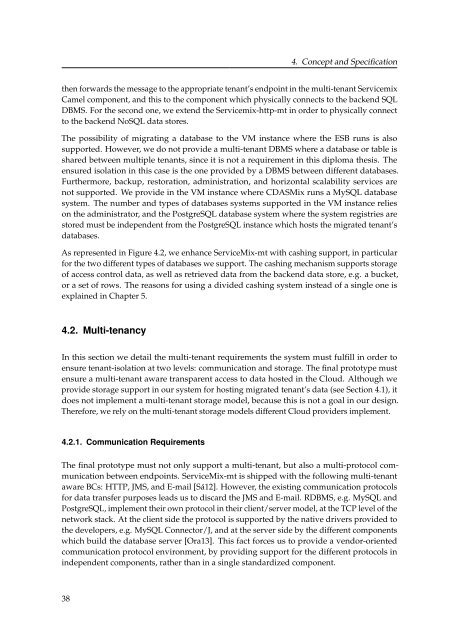Diploma Thesis Santiago Gómez Sáez - IAAS
Diploma Thesis Santiago Gómez Sáez - IAAS
Diploma Thesis Santiago Gómez Sáez - IAAS
Create successful ePaper yourself
Turn your PDF publications into a flip-book with our unique Google optimized e-Paper software.
4. Concept and Specification<br />
then forwards the message to the appropriate tenant’s endpoint in the multi-tenant Servicemix<br />
Camel component, and this to the component which physically connects to the backend SQL<br />
DBMS. For the second one, we extend the Servicemix-http-mt in order to physically connect<br />
to the backend NoSQL data stores.<br />
The possibility of migrating a database to the VM instance where the ESB runs is also<br />
supported. However, we do not provide a multi-tenant DBMS where a database or table is<br />
shared between multiple tenants, since it is not a requirement in this diploma thesis. The<br />
ensured isolation in this case is the one provided by a DBMS between different databases.<br />
Furthermore, backup, restoration, administration, and horizontal scalability services are<br />
not supported. We provide in the VM instance where CDASMix runs a MySQL database<br />
system. The number and types of databases systems supported in the VM instance relies<br />
on the administrator, and the PostgreSQL database system where the system registries are<br />
stored must be independent from the PostgreSQL instance which hosts the migrated tenant’s<br />
databases.<br />
As represented in Figure 4.2, we enhance ServiceMix-mt with cashing support, in particular<br />
for the two different types of databases we support. The cashing mechanism supports storage<br />
of access control data, as well as retrieved data from the backend data store, e.g. a bucket,<br />
or a set of rows. The reasons for using a divided cashing system instead of a single one is<br />
explained in Chapter 5.<br />
4.2. Multi-tenancy<br />
In this section we detail the multi-tenant requirements the system must fulfill in order to<br />
ensure tenant-isolation at two levels: communication and storage. The final prototype must<br />
ensure a multi-tenant aware transparent access to data hosted in the Cloud. Although we<br />
provide storage support in our system for hosting migrated tenant’s data (see Section 4.1), it<br />
does not implement a multi-tenant storage model, because this is not a goal in our design.<br />
Therefore, we rely on the multi-tenant storage models different Cloud providers implement.<br />
4.2.1. Communication Requirements<br />
The final prototype must not only support a multi-tenant, but also a multi-protocol communication<br />
between endpoints. ServiceMix-mt is shipped with the following multi-tenant<br />
aware BCs: HTTP, JMS, and E-mail [Sá12]. However, the existing communication protocols<br />
for data transfer purposes leads us to discard the JMS and E-mail. RDBMS, e.g. MySQL and<br />
PostgreSQL, implement their own protocol in their client/server model, at the TCP level of the<br />
network stack. At the client side the protocol is supported by the native drivers provided to<br />
the developers, e.g. MySQL Connector/J, and at the server side by the different components<br />
which build the database server [Ora13]. This fact forces us to provide a vendor-oriented<br />
communication protocol environment, by providing support for the different protocols in<br />
independent components, rather than in a single standardized component.<br />
38

















